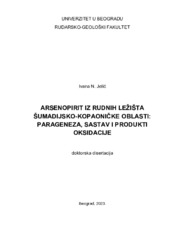Приказ основних података о дисертацији
Arsenopirit iz rudnih ležišta Šumadijsko-kopaoničke oblasti: paregeneza, sastav i produkti oksidacije
Arsenopyrite from the ore deposits of Šumadija-Kopaonik zone: paragenesis, composition and products of oxidation
| dc.contributor.advisor | Pačevski, Aleksandar | |
| dc.contributor.other | Kremenović, Aleksandar | |
| dc.contributor.other | Stojanović, Jovica | |
| dc.creator | Jelić, Ivana | |
| dc.date.accessioned | 2023-12-20T22:45:04Z | |
| dc.date.available | 2023-12-20T22:45:04Z | |
| dc.date.issued | 2023-09-20 | |
| dc.identifier.uri | https://eteze.bg.ac.rs/application/showtheses?thesesId=9430 | |
| dc.identifier.uri | https://fedorabg.bg.ac.rs/fedora/get/o:32026/bdef:Content/download | |
| dc.identifier.uri | https://plus.cobiss.net/cobiss/sr/sr/bib/127612425 | |
| dc.identifier.uri | https://nardus.mpn.gov.rs/handle/123456789/22016 | |
| dc.description.abstract | Arsenopirit, FeAsS je čest pratilac polimetaličnih orudnjenja Šumadijsko-kopaoničke oblasti. Jedan je od sulfida koji u najvećoj meri koncentriše zlato. Nepoželjan je u rudama jer njegovom oksidacijom na jalovištima može doći do oslobađanja arsena koji spada u elemente toksične za životnu sredinu. U okviru ovog doktorata sistematski su ispitivani arsenopiriti iz različitih stadijuma i tipova orudnjenja rudnih ležišta i mineralizacija Šumadijsko-kopaoničke oblasti (Rudnik, Sastavci, Trepča, Gokčanica – Drenjak i Rujak, Golijska reka i Jurija). Uzorci arsenopirita ispitivani su polarizacionom mikroskopijom u odbijenoj svetlosti, SEM-EDS i XRPD metodom. Utvrđeno je da svi ispitivani arsenopiriti kristališu monoklinično u prostornoj grupi P21/c. Sadržaji arsena u opsegu od 32.2 do 34.3 at.% As dobijeni su na osnovu određenih parametra jedinične ćelije i vrednosti d131 međupljosnog rastojanja. Ustanovljeno je da postoje brojni ograničavajući faktori za primenu arsenopirita kao geotermometra. Od hemijskih primesa arsenopirit najčešće sadrži Co, Ni i Sb. Samorodno zlato prisutno je jedino u sulfidnim pojavama Drenjaka. Zlato se javlja uglavnom u vidu zrna veličine do 20 μm u arsenopiritu i u skoroditu. Zlato u arsenopiritu zapunjava mikropukotine i pore, u kojima često asocira sa bizmutinitom i samorodnim bizmutom. Zaključak je da je zlato deponovano nakon kristalizacije arsenopirita, zajedno sa Bi mineralima, i da Au-Bi-(As) korelacija može biti od značaja za razumevanje migracije i koncentrisanje zlata u okviru magmatsko-vulkanskih kompleksa Šumadijsko- kopaoničke oblasti. TEM metodom utvrđeno je i prisustvo nanočestica zlata u ovim mineralima. Skorodit i farmakosiderit su najčešći produkti alteracije arsenopirita. | sr |
| dc.description.abstract | Arsenopyrite, FeAsS is often present in the polymetallic deposits in the Šumadija-Kopaonik zone. It is one of the sulphides that concentrate gold to the greatest extent. It is undesirable in these ores because its oxidation in tailings can lead to the release of arsenic. Within the framework of this thesis, arsenopyrites from different stages and mineralization types of deposits of Šumadija-Kopaonik zone (Rudnik, Sastavci, Trepča, Gokčanica - Drenjak and Rujak, Golijska reka and Jurija) were systematically examined. Samples of arsenopyrite were examined by polarized-light microscopy in reflected light, SEM-EDS, XRPD methods. All investigated arsenopyrites are monoclinic and crystallize in space group P21/c. Arsenic contents in the range of 32.2 to 34.3 at. % As were obtained based on determined unit cell parameters and values of d131. It was established that there are numerous limiting factors for the use of arsenopyrite as a geothermometer. Of the chemical impurities, arsenopyrite most often contains Co, Ni and Sb. The presence of native gold in arsenopyrite was determined only in the sulfide occurrences of Drenjak. Gold occurs mainly in the form of grains up to 20 μm in size, both in arsenopyrite and in scorodite. Gold in arsenopyrite fills microcracks and pores, where it is often associated with bismuthinite and native bismuth. It was concluded that the gold was deposited after the crystallization of arsenopyrite, together with Bi minerals, and that the Au-Bi-(As) correlation can be important for understanding the migration and concentration of gold within the magmatic- volcanic complexes of the Šumadija-Kopaonik zone. The presence of gold nanoparticles in these minerals was determined by TEM. Scorodite and pharmacosiderite are the most common alteration products of arsenopyrite. | en |
| dc.format | application/pdf | |
| dc.language | sr | |
| dc.publisher | Универзитет у Београду, Рударско-геолошки факултет | sr |
| dc.rights | openAccess | en |
| dc.rights.uri | https://creativecommons.org/licenses/by-nc-nd/4.0/ | |
| dc.source | Универзитет у Београду | sr |
| dc.subject | arsenopirit, zlato, skorodit, Šumadijsko-kopaonička oblast, parageneza, zonarnost | sr |
| dc.subject | arsenopyrite, gold, scorodite, Šumadija-Kopaonik zone, paragenesis, zoning | en |
| dc.title | Arsenopirit iz rudnih ležišta Šumadijsko-kopaoničke oblasti: paregeneza, sastav i produkti oksidacije | sr |
| dc.title.alternative | Arsenopyrite from the ore deposits of Šumadija-Kopaonik zone: paragenesis, composition and products of oxidation | en |
| dc.type | doctoralThesis | |
| dc.rights.license | BY-NC-ND | |
| dc.identifier.fulltext | http://nardus.mpn.gov.rs/bitstream/id/158104/Disertacija_14575.pdf | |
| dc.identifier.fulltext | http://nardus.mpn.gov.rs/bitstream/id/158105/Referat.pdf | |
| dc.identifier.rcub | https://hdl.handle.net/21.15107/rcub_nardus_22016 |



